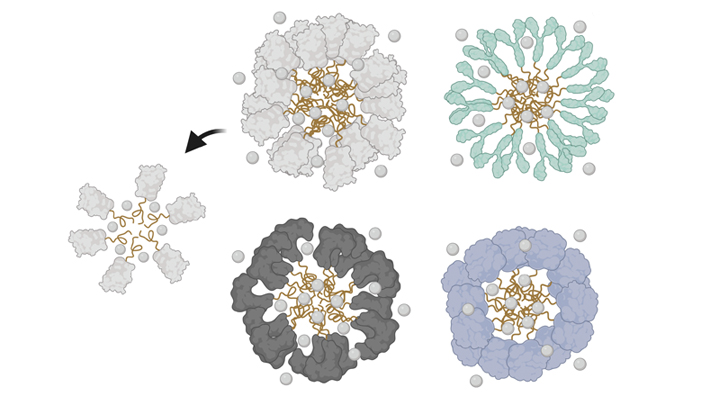Biofabrication of functional protein nanoparticles through simple His-tag engineering

Researchers from the IBB-UAB Nanobiotechnology group in collaboration with CIBER-BBN and ICTS-Nanbiosis-PPP have developed a new technique for the fabrication of protein nanoparticles with unique and useful functionalities in biomedicine and biotechnology. The efficient and economical synthesis procedure is performed using histidine peptides and divalent cations.
The current development of innovative medicines using protein-based materials is a pressing need1,2. However, it is a challenge to create complex and functional protein-based materials that are biologically safe and active, without using potentially toxic chemical couplers or cross-linkers3,4. That is why, conferring self-assembling abilities to clinically oriented polypeptides is mandatory, but still requires a painstaking protein engineering process5,6. Curiously, the formation of supramolecular protein materials is common in nature, but achieving safe nanoscale materials using single-step procedures that can assist in a diversity of clinical field is a major challenge7.
The present study exhibits a novel biochemical approach (developed by the Nanobiotechnology group led by Prof. Antonio Villaverde Corrales; IBB-UAB, in collaboration with the ICTS “NANBIOSIS”, more specifically the Protein Production Platform of CIBER in Bioengineering, Biomaterials & Nanomedicne (CIBER-BBN) and IBB, at the UAB) which enables the fabrication of custom-designed multimeric nanoparticles using a simple histidine tag peptide and divalent cations (e.g., zinc). The resultant gluing effect triggered by this method offers a sustainable, green, and highly efficient way of producing nanoparticles that possess unique functionalities. The generated structures are regular in size (ranging from 10 to 15 nm), architecturally stable (specially upon increasing temperatures; from 4 to 50 °C), functional in different scenarios, and act as intermediate-stage entities for the subsequent formation of smart microparticles8, which mimic the naturally occurring human secretory granules and that can effectively release the therapeutical load (meaning protein-based nanoparticles) in a sustained manner9,10.
The salient feature of this approach lies in the fact that most of the recombinant proteins produced by the biochemical and biotechnological industries for biomedical research are already equipped with the His-tag11. Therefore, this green biofabrication procedure can be effortlessly applied to a broad spectrum of protein species, facilitating the conversion of an array of proteins into their respective nano and micro-structured formats in a cost-effective manner.
A schematic depiction of the biofabrication process for histidine tagged proteins, with biotechnological significance, is presented. Divalent cations are employed as gluing agents, at varying concentrations, to facilitate the structural reorganization of proteins into nano and micro-particulate structures. Created with Biorender.com.
In summary, this innovative technique represents a significant advancement in the field of biofabrication, providing researchers with a powerful tool for creating tailored nanomaterials for a variety of different biomedical and biotechnological applications. It has the potential to revolutionize the way we produce and utilize nanoparticles, opening up new avenues for research and development across a wide range of domains.
(1) Institut de Biotecnologia i de Biomedicina, Universitat Autònoma de Barcelona
(2) Departament de Genètica i de Microbiologia, Universitat Autònoma de Barcelona
(3) CIBER de Bioingeniería, Biomateriales y Nanomedicina (CIBER-BBN), Madrid
(4) Biomedical Research Institute Sant Pau (IIB-Sant Pau), Hospital de la Santa Creu i Sant Pau
References
López-Laguna, H., Sánchez, J. M., Carratalá, J. V., Rojas-Peña, M., Sánchez-García, L., Parladé, E., Sánchez-Chardi, A., Voltà-Durán, E., Serna, N., Cano-Garrido, O., Flores, S., Ferrer-Miralles, N., Nolan, V., De Marco, A., Roher, N., Unzueta, U., Vazquez, E., & Villaverde, A. (2021). Biofabrication of functional protein nanoparticles through simple His-tag engineering. ACS Sustainable Chemistry and Engineering, 9(36). https://doi.org/10.1021/acssuschemeng.1c04256
1. Silva NHCS, Vilela C, Marrucho IM, Freire CSR, Pascoal Neto C, Silvestre AJD. Protein-based materials: from sources to innovative sustainable materials for biomedical applications. J Mater Chem B. 2014;2(24):3715.
2. Gagner JE, Kim W, Chaikof EL. Designing protein-based biomaterials for medical applications. Acta Biomater. 2014 Apr;10(4):1542–57.
3. Song K, Xu H, Mu B, Xie K, Yang Y. Non-toxic and clean crosslinking system for protein materials: Effect of extenders on crosslinking performance. J Clean Prod. 2017 May;150:214–23.
4. Miserez A, Yu J, Mohammadi P. Protein-Based Biological Materials: Molecular Design and Artificial Production. Chem Rev. 2023 Mar 8;123(5):2049–111.
5. Katyal P, Meleties M, Montclare JK. Self-Assembled Protein- and Peptide-Based Nanomaterials. ACS Biomater Sci Eng. 2019 Sep 9;5(9):4132–47.
6. Wang Y, Katyal P, Montclare JK. Protein-Engineered Functional Materials. Adv Healthc Mater. 2019 Jun 2;8(11):1801374.
7. Hamley IW. Protein Assemblies: Nature-Inspired and Designed Nanostructures. Biomacromolecules. 2019 May 13;20(5):1829–48.
8. López-Laguna H, Parladé E, Álamo P, Sánchez JM, Voltà-Durán E, Serna N, et al. In Vitro Fabrication of Microscale Secretory Granules. Adv Funct Mater. 2021 May 17;31(21):2100914.
9. Álamo P, Parladé E, López-Laguna H, Voltà-Durán E, Unzueta U, Vazquez E, et al. Ion-dependent slow protein release from in vivo disintegrating micro-granules. Drug Deliv. 2021 Jan 1;28(1):2383–91.
10. Sánchez JM, López-Laguna H, Álamo P, Serna N, Sánchez-Chardi A, Nolan V, et al. Artificial Inclusion Bodies for Clinical Development. Advanced Science. 2020 Feb 27;7(3):1902420.
11. López-Laguna H, Voltà-Durán E, Parladé E, Villaverde A, Vázquez E, Unzueta U. Insights on the emerging biotechnology of histidine-rich peptides. Biotechnol Adv. 2022 Jan;54:107817.


